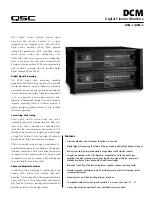
Manual-7
SOUND SYSTEM INTERCONNECTION
properly, connecting both ends of the shield is not often
practiced, since doing so can create noisy interconnections.
A common solution to these noisy hum and buzz problems
involves disconnecting one end of the shield, even though one
can not buy off-the-shelf cables with the shield disconnected
at one end. The best end to disconnect is a matter of personal
preference and should be religiously obeyed; choose inputs or
outputs and always lift the side you choose (our drawings
happen to disconnect the outputs). If one end of the shield is
disconnected, the noisy hum current stops flowing and away
goes the hum — but only at low frequencies. A one-end-only
shield connection increases the possibility of high frequency
(radio) interference since the shield may act as an antenna.
Many reduce this potential RF interference by providing an
RF path through a small capacitor (0.1 or 0.01 microfarad
ceramic disc) connected from the lifted end of the shield to
the chassis. The fact that many modern day installers still
follow this one-end-only rule with consistent success indi-
cates this and other acceptable solutions to RF issues exist,
though the increasing use of digital and wireless technology
greatly increases the possibility of future RF problems.
See the following page for suggested cable assemblies for
your particular interconnection needs. Find the appropriate
output configuration from either your mixer output or the MX
22 output (down the left side), and then match this with the
correct balanced or unbalanced input to the MX 22 or the
amplifer (down the right side.) An “off-the-shelf” cable may
be available or modifiable. Soldering should only be at-
tempted by those trained in the art.
SUMMARY
If you are unable to do things correctly (i.e. use fully
balanced wiring with shields tied to the
chassis
at the point of
entry, or transformer isolate all unbalanced signals from
balanced signals) then there is no guarantee that a hum free
interconnect can be achieved, nor is there a definite scheme
that will assure noise free operation in all configurations.
WINNING THE WIRING WARS
• Use balanced connections whenever possible.
• Transformer isolate all unbalanced connections from
balanced connections.
• Use special cable assemblies when unbalanced lines cannot
be transformer isolated.
• Any unbalanced cable must be kept under ten feet (three
meters) in length. Lengths longer than this will amplify
the nasty side effects of unbalanced circuitry's ground
loops.
This information was condensed from Rane Note 110,
“Sound System Interconnection”. If you would like the
complete note, call or email the factory, download it from
Rane's web site, or ask your dealer for a copy.
Rane’s policy is to accommodate rather than dictate.
However, this document contains suggestions for external
wiring changes that should ideally only be implemented by
trained technical personnel. Safety regulations require that all
original grounding means provided from the factory be left
intact for safe operation. No guarantee of responsibility for
incidental or consequential damages can be provided.
(In
other words, don’t modify cables, or try your own version of
grounding unless you really understand exactly what type of
output and input you have to connect.)
THE ABSOLUTE BEST RIGHT WAY TO DO IT
Use balanced lines and
tie the cable shield to the metal
chassis (right where it enters the chassis) at both ends of the
cable
.
A balanced line requires three separate conductors, two of
which are signal (+ and –) and one shield. The shield serves
to guard the sensitive audio lines from interference. Only by
using balanced line interconnects can you
guarantee
(yes,
guarantee
) hum-free results. Always use twisted pair cable.
Chassis tying the shield at each end also
guarantees
the best
possible protection from RFI [radio frequency interference]
and other noises [neon signs, lighting dimmers].
THE NEXT BEST RIGHT WAY TO DO IT
The quickest, quietest and most foolproof method to
connect balanced and unbalanced is to
transformer isolate
all unbalanced connections
. Your audio dealer can recom-
mend such a transformer.
The goal of transformer adaptors is to allow the use of
standard cables.
With these transformer isolation boxes,
modification of cable assemblies is unnecessary. Virtually
any two pieces of audio equipment can be successfully
interfaced without risk of unwanted hum and noise.
Another way to create the necessary isolation is to use a
direct box.
Originally named for its use to convert the high
impedance, high level output of an electric guitar to the low
impedance, low level input of a recording console, it allowed
the player to plug “directly” into the console. Now this term is
commonly used to describe any box used to convert unbal-
anced lines to balanced lines.
THE LAST BEST RIGHT WAY TO DO IT
If transformer isolation is not an option, special cable
assemblies are a last resort.
The key here is to prevent the
shield currents from flowing into a unit whose grounding
scheme creates ground loops (hum) in the audio path (i.e.,
most audio equipment). Do not be tempted to use 3-prong to
2-prong “cheater” adapters to lift grounds. This is a danger-
ous and illegal practice.
It is true that connecting both ends of the shield is theo-
retically the best way to interconnect equipment – though this
assumes the interconnected equipment is internally grounded
properly. Since most equipment is
not
internally grounded


















